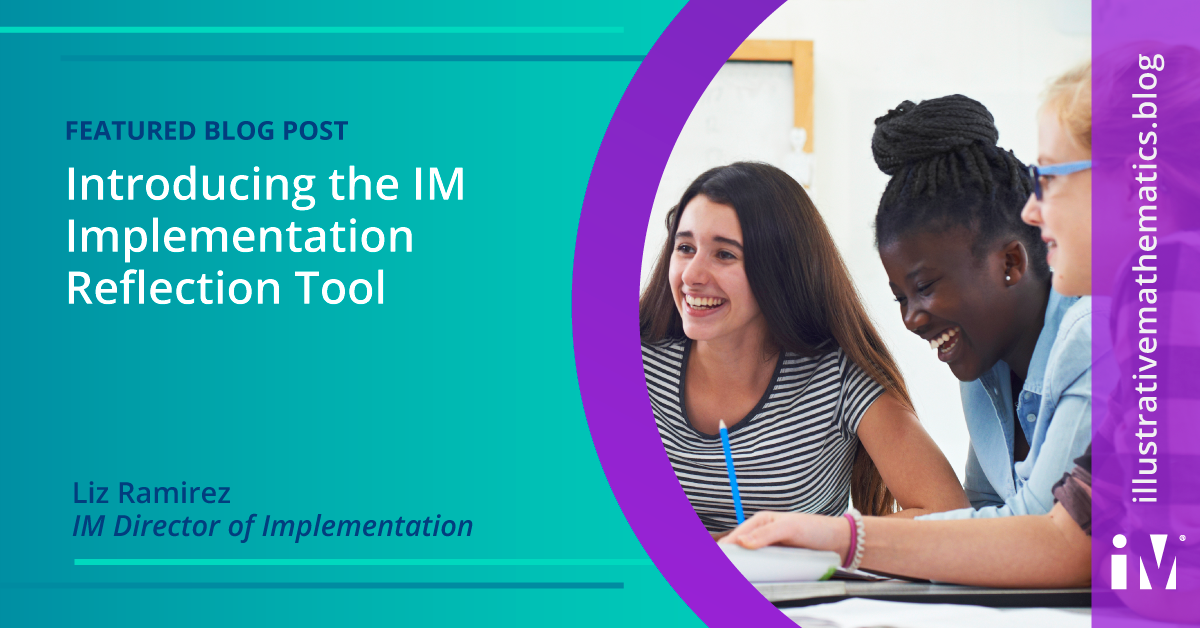by Liz Ramirez, Director of Implementation
“This makes the expectations for what I need to change visible.”
“It’s not about the tool. It’s about the conversation using the tool.”
Quotes from leaders who participated in IM’s collaborative research partnership this past year.
Introducing the IM Implementation Reflection Tool
The IM Implementation Reflection Tool supports collaborative conversations and deep reflection about strengths and opportunities for improvement of math instruction. It is a non-evaluative resource to enhance classroom observation, reflection, and feedback. It helps all stakeholders communicate clearly what a robust, meaningful, and dynamic implementation can look like. Such clarity has the potential to help leaders and teachers alike understand the specific actions that could open opportunities for meaningful and culturally relevant adaptations. We hope that this work might act as a source of inspiration for schools to work together to self-assess and grow their teaching and learning over time.
In the tool, you’ll find a detailed Progressions of Practice that goes beyond a basic ‘walkthrough’ checklist. Such clarity about the progression of practice can serve as meaningful guidance and a catalyst for change across three levels of the education system: the classroom, the team, and the school at large. These three levels work together to drive successful implementation. The first two sections, on the school and team levels, consist of reflection questions that help participants decide where they lie on a defined progression of practice for that section. The third section, on the classroom levels, consists of classroom observation protocols.
The tool begins with schoolwide implementation, to highlight the importance of a coherent, shared vision in implementation success.
SECTION A: School Implementation
District and school leaders are uniquely positioned to support implementation by removing systemic barriers that inhibit using the curriculum with integrity, and promoting factors that facilitate it. Section A of the tool contains two strands. Section A1 includes a Progression of Practice that assesses the school-level factors that influence the day-to-day teaching practices. These practices directly impact student outcomes. Section A2 focuses on facilitating professional growth.
Questions for Reflection include:
- What is your shared vision for mathematics teaching and learning?
- What are your plans for supporting implementation of the IM curriculum?
- How do school administrators work with math coaches to co-plan, set goals, conduct classroom observations, and provide feedback?
- Which professional learning opportunities (e.g., training, coaching, PLCs, and feedback) do you use to support teacher implementation of the IM curriculum?
SECTION B: Team Implementation
Section B1 focuses on the practices of individual teachers as they plan units and lessons. Teachers can work individually or with a coach to reflect on their use of the curriculum materials and evidence of student learning to inform lesson planning, and their use assessments for feedback and learning.
Questions for Reflection include:
- How do you factor in the curriculum, knowledge of your students, local context, and your own experience when you plan lessons? How do you use IM assessments? What feedback do you give students about their performance? How do students use the feedback?
- How do you make decisions about the timing of an activity or unit?
- How do you plan to address the diverse needs of students, including students with disabilities and English learners?
Section B2 focuses on the team structures that best empower teachers, regardless of which courses they teach, to come together to plan, learn, and grow professionally. This section invites leaders and coaches to facilitate opportunities for teachers to establish shared goals, participate in collaborative planning sessions, collect and use evidence of student learning, and reflect upon their teaching practice.
Questions for Reflection include:
- How do teachers work together to develop shared goals around key instructional practices that align to the IM Certified professional learning experiences throughout the year?
- How do teachers designate time during collaborative planning sessions to discuss all elements of lesson design, including key lesson concepts and evidence of student learning?
- How do teachers collaboratively collect and use evidence of student learning from varied sources to inform shared goals and opportunities to improve practice?
SECTION C: Classroom Implementation
Section C focuses on teachers’ instructional practices and on the resulting student learning behaviors that can be observed. This section can be used by leadership teams as a non-evaluative classroom observation protocol or by teachers as a self-assessment.
Section C1 focuses on how teachers use the IM design structure, learning goals, and instructional routines as key instructional resources in the lesson.
Section C2 focuses on the instructional practices that teachers enact as they facilitate the lesson in the classroom. This includes how the teacher cultivates a positive, inclusive, and equitable learning environment, where student thinking is valued. It also includes how the teacher launches activities, formulates questions, engages students in meaningful discussions, and synthesizes student learning.
Section C3 focuses on the student learning behaviors. In problem-based classrooms using IM materials, observers can look for evidence of student engagement and belonging to the learning community via effective independent and collaborative problem-solving, communication of mathematical ideas, and productive struggle.
Download IM Implementation Reflection Tool
IM Implementation Reflection Tool (Grades K–5)
IM Implementation Reflection Tool (Grades 6–12)
Next Steps
Please contact IM to learn more about how to interpret, use, and implement this tool in your district or school.
Thank you for participating in our efforts to support district implementation of IM, and to help us create “a world where all learners know, use, and enjoy mathematics.”
